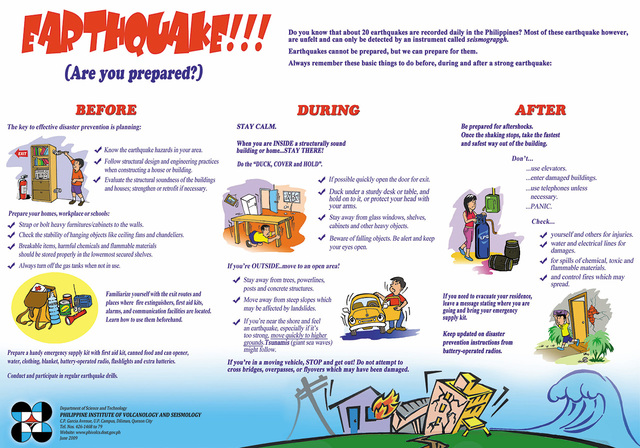Earthquake tips: what to do before, during, and after
Meant to be shared online, the Earthquake Preparedness Guide can help Filipinos prepare for earthquakes and possible aftershocks
MANILA, Philippines (UPDATED) – The Philippine Institute of Volcanology and Seismology (Phivolcs) has been urging the public to be prepared for earthquakes, considering that they are unpredictable and may strike anytime. (READ: What dangers await when the West Valley Fault moves)
In an Earthquake Preparedness Guide on its website, Phivolcs lists the things one should do before, during and after an earthquake.
During an earthquake, Phivolcs advises affected persons to stay indoors if they are already within a structurally sound building or home. In particular, the agency cites the following tips:
- If possible, quickly open the door for exit
- Duck under a sturdy desk or table, and hold on to it, or protect your head with your arms
- Stay away from glass windows, shelves, cabinets, and other heavy objects
- Beware of falling objects. Be alert and keep your eyes open
Meanwhile, those who are outside should move to an open area, and follow these safety measures:
- Stay away from trees, power lines, posts, and concrete structures
- Move away from steep slopes which may be affected by landslides
- If near the shore and feeling an earthquake, especially a strong one, quickly move to higher grounds in anticipation of possible tsunamis
Those who are in a moving vehicle should stop and get out, the agency adds. “Do not attempt to cross bridges, overpasses, or flyovers which may have been damaged.” (READ: Earthquake tips for drivers: Don’t panic)
Following an earthquake
Immediately after an earthquake, Phivolcs advises affected persons to take “the fastest and safest way out of the building.” One should not use elevators, enter damaged buildings, or use telephones unless necessary, the agency says.
Most of all, do not panic, according to Phivolcs.
Meanwhile, before an earthquake, the agency emphasizes planning. (See the rest of the Phivolcs infographic below)
A 2004 study conducted by the Japan International Cooperation Agency, the Metro Manila Earthquake Impact Reduction Study (MMEIRS), indicated that an earthquake hitting Metro Manila could destroy 40% of the buildings in the metropolis and kill about 34,000.
On Friday, July 3, 2015, a 6.1-magnitude earthquake hit parts of Mindanao and Eastern Visayas with the epicenter located 41 km northeast of Burgos town in Surigao del Norte.
Source: Rappler Article – May 28th, 2016
Original Article Link: Rappler

